语言学整理
- 格式:doc
- 大小:175.00 KB
- 文档页数:27
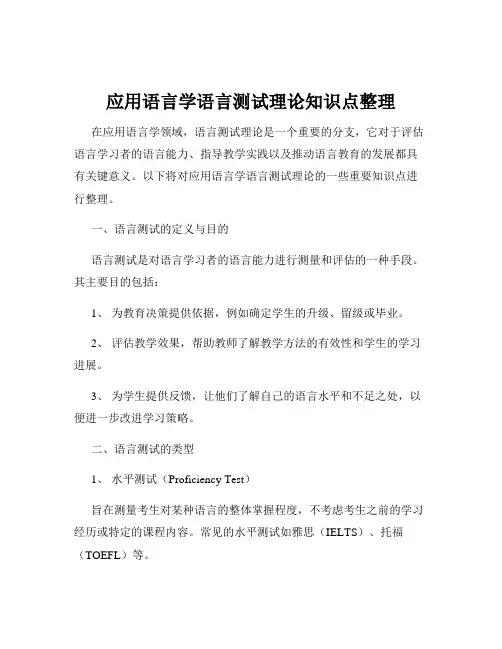
应用语言学语言测试理论知识点整理在应用语言学领域,语言测试理论是一个重要的分支,它对于评估语言学习者的语言能力、指导教学实践以及推动语言教育的发展都具有关键意义。
以下将对应用语言学语言测试理论的一些重要知识点进行整理。
一、语言测试的定义与目的语言测试是对语言学习者的语言能力进行测量和评估的一种手段。
其主要目的包括:1、为教育决策提供依据,例如确定学生的升级、留级或毕业。
2、评估教学效果,帮助教师了解教学方法的有效性和学生的学习进展。
3、为学生提供反馈,让他们了解自己的语言水平和不足之处,以便进一步改进学习策略。
二、语言测试的类型1、水平测试(Proficiency Test)旨在测量考生对某种语言的整体掌握程度,不考虑考生之前的学习经历或特定的课程内容。
常见的水平测试如雅思(IELTS)、托福(TOEFL)等。
2、成绩测试(Achievement Test)侧重于检测考生在特定课程或学习阶段所掌握的语言知识和技能,与教学内容紧密相关。
比如学校的期末考试、单元测验等。
3、诊断测试(Diagnostic Test)主要用于发现考生在语言学习中存在的具体问题和薄弱环节,以便为后续的教学和学习提供针对性的指导。
4、潜能测试(Aptitude Test)预测考生学习语言的潜力和能力,而非对现有语言水平的评估。
三、语言测试的质量评估标准1、效度(Validity)指测试能够准确测量出其所要测量的语言能力或语言知识的程度。
效度分为内容效度、结构效度、预测效度等。
内容效度:测试内容是否涵盖了所要考查的语言技能和知识点。
结构效度:测试结果是否与语言能力的理论结构相一致。
预测效度:测试成绩能否有效地预测考生在未来语言学习或实际语言运用中的表现。
2、信度(Reliability)反映测试结果的稳定性和一致性。
包括重测信度、复本信度、分半信度等。
重测信度:对同一批考生在不同时间进行相同测试,两次测试结果的相关性。
复本信度:使用两份内容相似但不完全相同的试卷对同一批考生进行测试,两次结果的相关性。
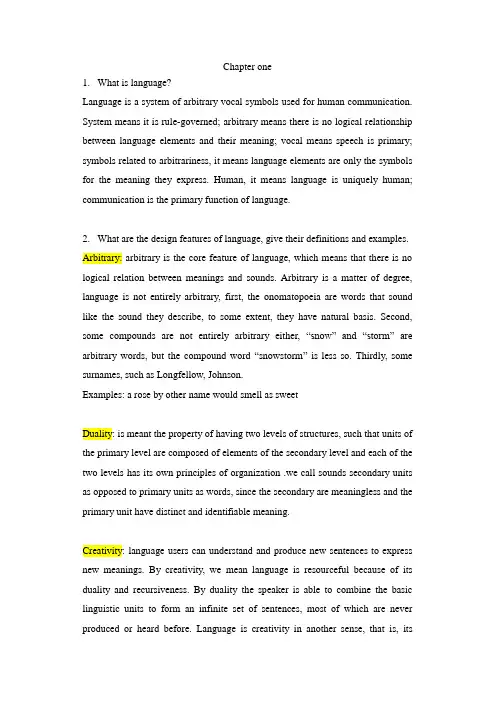
Chapter one1.What is language?Language is a system of arbitrary vocal symbols used for human communication. System means it is rule-governed; arbitrary means there is no logical relationship between language elements and their meaning; vocal means speech is primary; symbols related to arbitrariness, it means language elements are only the symbols for the meaning they express. Human, it means language is uniquely human; communication is the primary function of language.2.What are the design features of language, give their definitions and examples. Arbitrary: arbitrary is the core feature of language, which means that there is no logical relation between meanings and sounds. Arbitrary is a matter of degree, language is not entirely arbitrary, first, the onomatopoeia are words that sound like the sound they describe, to some extent, they have natural basis. Second, some compounds are not entirely arbitrary either, “snow” and“storm” are arbitrary words, but the compound word “snowstorm”is less so. Thirdly, some surnames, such as Longfellow, Johnson.Examples: a rose by other name would smell as sweetDuality: is meant the property of having two levels of structures, such that units of the primary level are composed of elements of the secondary level and each of the two levels has its own principles of organization .we call sounds secondary units as opposed to primary units as words, since the secondary are meaningless and the primary unit have distinct and identifiable meaning.Creativity: language users can understand and produce new sentences to express new meanings. By creativity, we mean language is resourceful because of its duality and recursiveness. By duality the speaker is able to combine the basic linguistic units to form an infinite set of sentences, most of which are never produced or heard before. Language is creativity in another sense, that is, itspotential to create endless sentences. The recursive nature of language provides a theoretical basis of this possibility.Example: He bought a book which was written by a teacher who taught in a school which was known for its graduates who……Displacement: means that human languages enable their users to symbolize objects, events and concepts, which are not present at the moment of communication.Examples : we can refer to Confucius and Bush at the moment of communication , but the former lived thousands of years ago and the latter live far away from us .3.Functions of the language and their examples⑴informative function: when language is used to express human experience and knowledge about the world. It is predominantly the major role of language.⑵interpersonal function is the most important sociological use of language by which people establish and maintain their status in a society. Language marks our identity, physically in terms of age, sex, and voiceprints; psychologically in terms of language, personality, and intelligence; geographically in terms of accents and dialects; ethnically and socially in terms of social stratification, class, status, role, solidarity, and distance.(3) Performative function: is primarily to change the social status of persons, as in marriage ceremonies, the sentencing of criminals, the blessing of children, the naming of a ship at a launching ceremony and the cursing of enemies. The kind of language employed in performative verbal acts is usually quite formal and even ritualized.(4) Emotive function: changes the emotional status of an audience for or against someone or something.(5) Phatic communion: occurs when language is used for pure interpersonal purposes, e.g. greetings, farewell, etc.(6) Recreational function: when language is used for the pure joy of using it, such as baby’s babbling and chanter’s chanting.(7) Metalingual function: when language is used to discuss itself. For example, to be honest, to make a long story short, come to think of it, on second thought.4. What is linguistics?Linguistics is the scientific study of language.4.Main branches of the linguistics1)Phonetics: studies speech sounds, it is the description, classification, andtranscription of speech sounds. It includes articulatory phonetics, acoustic phonetics and auditory phonetics.2)Phonology: the study of speech sounds as a system: the relations betweenspeech sounds, the way in which speech sounds are related to meaning, the rules governing the structure, distribution and sequencing of speech sounds. 3)Morphology: the internal structures of words. It studies the minimal units ofmeaning-morphemes and word-formation processes.4)Syntax: studies the internal structure of sentences5)Semantics: the study of meaning as encoded in language6)Pragmatics: the study of language use, meaning in context5. Macrolinguistics1) Psycholinguistics investigates the interrelation of language and mind, in processing and producing utterances and in language acquisition. The psycholinguistics constraints on the form of grammar are studied. It also studies language development in the child, biological foundations of languages, and the relationship between language and cognition.2) Social linguistics: is an umbrella term, which covers a variety of different interest in language and society, including the social functions of language and the social characteristics of its users.3) Anthropological linguistics: anthropology and linguistics combined: the relationship between language and culture.4) Computational linguistics: the use of computers to process or produce human language: machine-translation, information retrieval, expert systems.6. Important distinction in linguistics1) Descriptive VS PrescriptiveThe distinction lies in prescribing how things ought to be and describing how things are. Describing language as it is used by its native speakers is descriptive; trying to lay down language rules for correct uses of language is prescriptive. To say linguistics is a descriptive science is to say that linguist tries to discover and record the rules to which the members of a language community actually conform and does not seek to impose upon them rules, or norms, of correctness.2) Synchronic VS diachronicStudying language as it is used at a particular point in time is synchronic study; studying language as it changes over time is a diachronic study.3) Langue Vs paroleSaussure distinguished the linguistic competence of the speaker and the actual phenomena or data of linguistics as langue and parole. Langue is the language system, which is social, essential, and stable while parole is the actual use of the language system, which is individual, accidental, and unstable.4) Competence VS performanceA language user’s underlying knowledge about the system of rules is called his linguistic competence, and performance refers to the actual use of language in concrete situation. (Chomsky)5) Syntagmatic VS paradigmatic relationsSyntagmatic relations are relations between units present in the same sequence or construction, syntagmatically related elements form structures.Paradigmatic relations are relations between a unit and other units that can replace it in a given sequence. Paradigmatically related units form systems.how he can get to his destination. Then you tell him all that you know about the course, including which bus or subway he should take. This is the very process in which you use your experience and knowledge to help him. If you have no idea about his destination, you would say “Sorry, I can’t help you”. At this moment, he may buy a map of the city. This is the reason why map came into being. Map provides the detailed information including not only the complicated and crossing roads, but also the course of bus and subway. Map is an instrument by that peopleuse language to show their experience and knowledge. By analogy, there are also many other instruments for people to express content, such as books, papers, magazines and dictionaries and so on. These forms are utilized by human to record the facts of social development; conversely, the recorded facts is a prerequisite of social development. Having talked so much, I believe there are two important points to be captured. 一是,人这个主体通过使用语言将内容传递出去;另一个是语言通过报纸、杂志、书、字典等的外在形式把知识和经验传递出去。
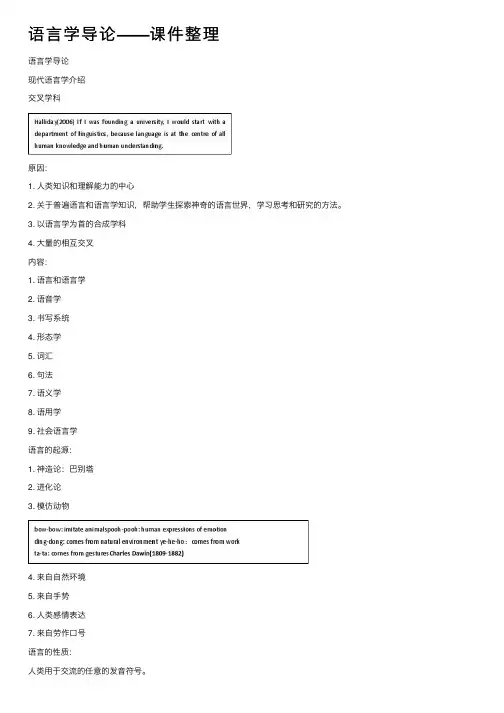
语⾔学导论——课件整理语⾔学导论现代语⾔学介绍交叉学科原因:1. ⼈类知识和理解能⼒的中⼼2. 关于普遍语⾔和语⾔学知识,帮助学⽣探索神奇的语⾔世界,学习思考和研究的⽅法。
3. 以语⾔学为⾸的合成学科4. ⼤量的相互交叉内容:1. 语⾔和语⾔学2. 语⾳学3. 书写系统4. 形态学5. 词汇6. 句法7. 语义学8. 语⽤学9. 社会语⾔学语⾔的起源:1. 神造论:巴别塔2. 进化论3. 模仿动物4. 来⾃⾃然环境5. 来⾃⼿势6. ⼈类感情表达7. 来⾃劳作⼝号语⾔的性质:⼈类⽤于交流的任意的发⾳符号。
⼀、语⾔是⼀种符号体系⼈们所指的物体与声⾳之间没有任何⾃然间的相似或联系。
社会习俗将词与物体、动作、观念联系起来,跨语⾔的社会习俗⼗分巨⼤。
1. 任意性2. 像似性理据:~语⾳学理据:。
拟声造字。
间接拟声构词(声⾳唤起动作)英语:PPT汉语:声象乎意;平声去声字意;声调不同意义改变,升调疑问,降调肯定;⼆、语⾔是⼀种交流的⼯具(思维)1)语⾔服从思维,是⼈类思想赖以表达的媒介或⼯具2)语⾔表达的思想具有可译性,不会⽤另⼀种语⾔来表达⽽损失其意义。
据说⼀种⼯具⼀经创造,它就独⽴于⼈甚⾄控制⼈和⼈的思维。
现在⼈服从语⾔。
现实的延伸取决于语⾔的发展。
语⾔制约着我们思考社会问题的⽅式。
……语⾔对思维的影响实例分析:1.特点:单⾳节字对应概念词影响:对仗⼯整,韵律节奏,表达模糊(上义词⽂化),统⼀辩证,同义反复思维极端,凑⾜⾳节识字重要所需要的能辨别意义的⾳节不多,不利于准确便捷的交际2.特点:双⾳节词3.特点:同义词影响:中国⽂化、政治和经济借以同⾳词⽽表现出特有的形式⽂化思维:诗歌,歇后语⽂化,谜语⽂化,⼴告⽂化,⼿机⽂化,外来词意译4.特点:形象思维(VS.抽象思维)影响:对事物的命名四字成语缺乏逻辑性三、语⾔是有系统的最基本的:声⾳与意义双重性语⾔的特征任意性线性离散性创造性(与双重性相关):低层:声⾳(⽆意义)⾼层:通过组合或重组的意义单元,可以组成⽆限的句⼦置换性(虚构)⽂化传递性语⾔分类1.遗传学分类(共同祖先—语系)2.类型分类(形态学的和句法结构)~形态结构:。
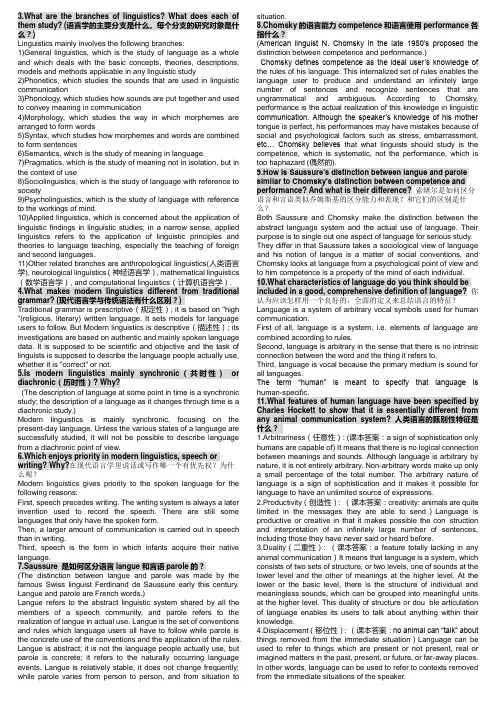
3.What are the branches of linguistics? What does each of them study? (语言学的主要分支是什么。
每个分支的研究对象是什么?)Linguistics mainly involves the following branches:1)General linguistics, which is the study of language as a whole and which deals with the basic concepts, theories, descriptions, models and methods applicable in any linguistic study2)Phonetics, which studies the sounds that are used in linguistic communication3)Phonology, which studies how sounds are put together and used to convey meaning in communication4)Morphology, which studies the way in which morphemes are arranged to form words5)Syntax, which studies how morphemes and words are combined to form sentences6)Semantics, which is the study of meaning in language.7)Pragmatics, which is the study of meaning not in isolation, but in the context of use8)Sociolinguistics, which is the study of language with reference to society9)Psycholinguistics, which is the study of language with reference to the workings of mind.10)Applied linguistics, which is concerned about the application of linguistic findings in linguistic studies; in a narrow sense, applied linguistics refers to the application of linguistic principles and theories to language teaching, especially the teaching of foreign and second languages.11)Other related branches are anthropological linguistics(人类语言学), neurological linguistics(神经语言学), mathematical linguistics (数学语言学), and computational linguistics(计算机语言学).4.What makes modern linguistics different from traditional grammar? (现代语言学与传统语法有什么区别?)Traditional grammar is prescriptive(规定性); it is based on "high "(religious, literary) written language. It sets models for language users to follow. But Modern linguistics is descriptive(描述性); its investigations are based on authentic and mainly spoken language data. It is supposed to be scientific and objective and the task of linguists is supposed to describe the language people actually use, whether it is "correct" or not.5.Is modern linguistics mainly synchronic(共时性)or diachronic(历时性)? Why?(The description of language at some point in time is a synchronic study; the description of a language as it changes through time is a diachronic study.)Modern linguistics is mainly synchronic, focusing on the present-day language. Unless the various states of a language are successfully studied, it will not be possible to describe language from a diachronic point of view.6.Which enjoys priority in modern linguistics, speech or writing? Why?在现代语言学里说话或写作哪一个有优先权?为什么呢?Modern linguistics gives priority to the spoken language for the following reasons:First, speech precedes writing. The writing system is always a later invention used to record the speech. There are still some languages that only have the spoken form.Then, a larger amount of communication is carried out in speech than in writing.Third, speech is the form in which infants acquire their native language.7.Saussure 是如何区分语言langue和言语parole的?(The distinction between langue and parole was made by the famous Swiss linguist Ferdinand de Saussure early this century. Langue and parole are French words.)Langue refers to the abstract linguistic system shared by all the members of a speech community, and parole refers to the realization of langue in actual use. Langue is the set of conventions and rules which language users all have to follow while parole is the concrete use of the conventions and the application of the rules. Langue is abstract; it is not the language people actually use, but parole is concrete; it refers to the naturally occurring language events. Langue is relatively stable, it does not change frequently; while parole varies from person to person, and from situation to situation.8.Chomsky的语言能力competence和语言使用performance各指什么?(American linguist N. Chomsky in the late 1950’s proposed the distinction between competence and performance.)Chomsky defines competence as the ideal user’s knowledge of the rules of his language. This internalized set of rules enables the language user to produce and understand an infinitely large number of sentences and recognize sentences that are ungrammatical and ambiguous. According to Chomsky, performance is the actual realization of this knowledge in linguistic communication. Although the speaker’s knowledge of his mother tongue is perfect, his performances may have mistakes because of social and psychological factors such as stress, embarrassment, etc… Chomsky believes that what linguists should study is the competence, which is systematic, not the performance, which is too haphazard (偶然的).9.How is Saussure’s distinction between langue and parole similar to Chomsky’s distinction between competence and performance? And what is their difference?索绪尔是如何区分语言和言语类似乔姆斯基的区分能力和表现?和它们的区别是什么?Both Saussure and Chomsky make the distinction between the abstract language system and the actual use of language. Their purpose is to single out one aspect of language for serious study. They differ in that Saussure takes a sociological view of language and his notion of langue is a matter of social conventions, and Chomsky looks at language from a psychological point of view and to him competence is a property of the mind of each individual. 10.What characteristics of language do you think should be included in a good, comprehensive definition of language?你认为应该怎样用一个良好的,全面的定义来总结语言的特征?Language is a system of arbitrary vocal symbols used for human communication.First of all, language is a system, i.e. elements of language are combined according to rules.Second, language is arbitrary in the sense that there is no intrinsic connection between the word and the thing it refers to.Third, language is vocal because the primary medium is sound for all languages.The term “human” is meant to specify that language is human-specific.11.What features of human language have been specified by Charles Hockett to show that it is essentially different from any animal communication system? 人类语言的甄别性特征是什么?1.Arbitrariness(任意性): (课本答案:a sign of sophistication only humans are capable of) It means that there is no logical connection between meanings and sounds. Although language is arbitrary by nature, it is not entirely arbitrary. Non-arbitrary words make up only a small percentage of the total number. The arbitrary nature of language is a sign of sophistication and it makes it possible for language to have an unlimited source of expressions.2.Productivity(创造性): (课本答案:creativity: animals are quite limited in the messages they are able to send)Language is productive or creative in that it makes possible the con¬struction and interpretation of an infinitely large number of sentences, including those they have never said or heard before.3.Duality(二重性): (课本答案:a feature totally lacking in any animal communication)It means that language is a system, which consists of two sets of structure, or two levels, one of sounds at the lower level and the other of meanings at the higher level. At the lower or the basic level, there is the structure of individual and meaningless sounds, which can be grouped into meaningful units at the higher level. This duality of structure or dou¬ble articulation of language enables its users to talk about anything within their knowledge.4.Displacement(移位性): (课本答案:no animal can “talk” about things removed from the immediate situation)Language can be used to refer to things which are present or not present, real or imagined matters in the past, present, or future, or far-away places. In other words, language can be used to refer to contexts removed from the immediate situations of the speaker.5. Cultural transmission(文化传递性):(课本答案:details of human language system are taught and learned while animals are born with the capacity to send out certain signals as a means of limited communication)While we are born with the ability to acquire language, the details of any language are not genetically transmitted, but instead have to be taught and learned.12.Do you think human language is entirely arbitrary? Why?人类的语言是否是完全任意的?为什么?Language is arbitrary in nature, it is not entirely arbitrary, because there are a limited number of words whose connections between forms and meanings can be logically explained to a certain extent, for example, the onomatopoeia, words which are coined on the basis of imitation of sounds by sounds such as bang, crash, etc.. Take compounds for another example. The two elements “photo” and “copy” in “photocopy” are non-motivated, but the compound is not arbitrary.2.What are the two major media of communication? Of the two, which one is primary and why? 语言交际的两大媒介是什么?哪一个是基本的交际媒介?为什么?Speech and writing are the major media of communication. Speech is considered primary over writing. The reasons are: speech is prior to writing in language evolution, speech plays a greater role in daily communications, and speech is the way in which people acquire their native language.3.What are the three branches of phonetics? How do they contribute to the study of speech sounds? 语音学的三个分支是什么。
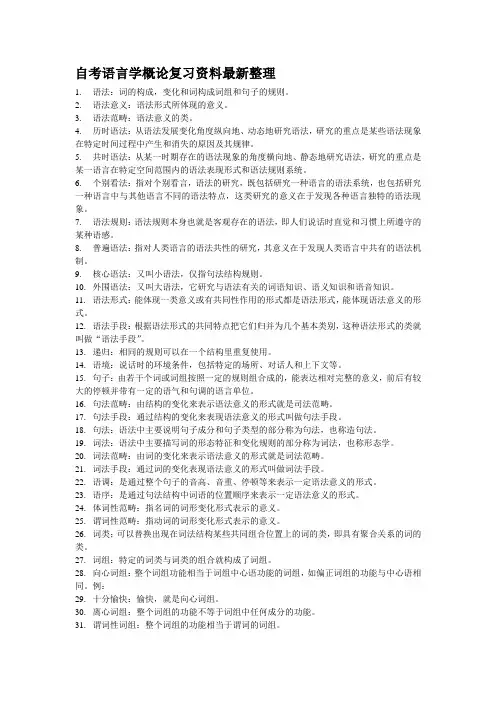
自考语言学概论复习资料最新整理1. 语法:词的构成,变化和词构成词组和句子的规则。
2. 语法意义:语法形式所体现的意义。
3. 语法范畴:语法意义的类。
4. 历时语法:从语法发展变化角度纵向地、动态地研究语法,研究的重点是某些语法现象在特定时间过程中产生和消失的原因及其规律。
5. 共时语法:从某一时期存在的语法现象的角度横向地、静态地研究语法,研究的重点是某一语言在特定空间范围内的语法表现形式和语法规则系统。
6. 个别看法:指对个别看言,语法的研究,既包括研究一种语言的语法系统,也包括研究一种语言中与其他语言不同的语法特点,这类研究的意义在于发现各种语言独特的语法现象。
7. 语法规则:语法规则本身也就是客观存在的语法,即人们说话时直觉和习惯上所遵守的某种语感。
8. 普遍语法:指对人类语言的语法共性的研究,其意义在于发现人类语言中共有的语法机制。
9. 核心语法:又叫小语法,仅指句法结构规则。
10. 外围语法:又叫大语法,它研究与语法有关的词语知识、语义知识和语音知识。
11. 语法形式:能体现一类意义或有共同性作用的形式都是语法形式,能体现语法意义的形式。
12. 语法手段:根据语法形式的共同特点把它们归并为几个基本类别,这种语法形式的类就叫做“语法手段”。
13. 递归:相同的规则可以在一个结构里重复使用。
14. 语境:说话时的环境条件,包括特定的场所、对话人和上下文等。
15. 句子:由若干个词或词组按照一定的规则组合成的,能表达相对完整的意义,前后有较大的停顿并带有一定的语气和句调的语言单位。
16. 句法范畴:由结构的变化来表示语法意义的形式就是司法范畴。
17. 句法手段:通过结构的变化来表现语法意义的形式叫做句法手段。
18. 句法:语法中主要说明句子成分和句子类型的部分称为句法,也称造句法。
19. 词法:语法中主要描写词的形态特征和变化规则的部分称为词法,也称形态学。
20. 词法范畴:由词的变化来表示语法意义的形式就是词法范畴。
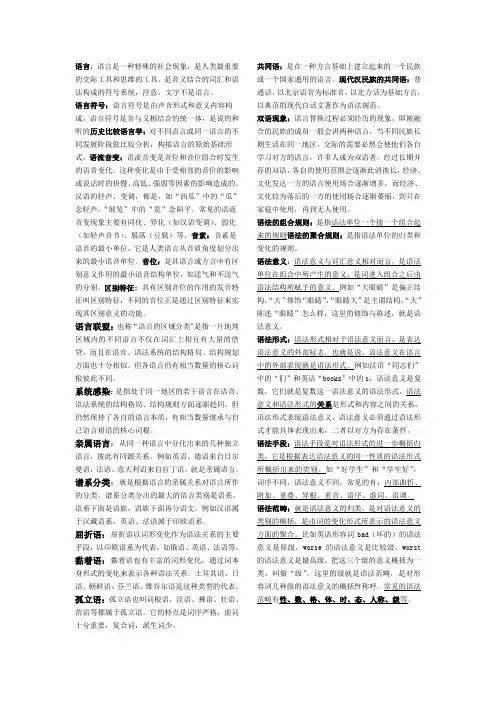
语言:语言是一种特殊的社会现象,是人类最重要的交际工具和思维的工具。
是音义结合的词汇和语法构成的符号系统,注意,文字不是语言。
语言符号:语言符号是由声音形式和意义内容构成,语言符号是音与义相结合的统一体,是说的和听的历史比较语言学:对不同语言或同一语言的不同发展阶段做比较分析,构拟语言的原始基础形式。
语流音变:语流音变是音位和音位组合时发生的语音变化。
这种变化是由于受相邻的音位的影响或说话时的快慢、高低、强弱等因素的影响造成的。
汉语的轻声、变调,都是,如“西瓜”中的“瓜”念轻声,“展览”中的“览”念阳平。
常见的语流音变现象主要有同化、异化(如汉语变调)、弱化(如轻声音节)、脱落(豆腐)等。
音素:音素是语音的最小单位,它是人类语言从音质角度划分出来的最小语音单位。
音位:是具语言或方言中有区别意义作用的最小语音结构单位,如送气和不送气的分别。
区别特征:具有区别音位的作用的发音特征叫区别特征,不同的音位正是通过区别特征来实现其区别意义的功能。
语言联盟:也称“语言的区域分类"是指一片地理区域内的不同语言不仅在词汇上相互有大量的借贷,而且在语音、语法系统的结构格局、结构规划方面也十分相似,但各语言仍有相当数量的核心词根彼此不同。
系统感染:是指处于同一地区的若干语言在语音、语法系统的结构格局、结构规则方面逐渐趋同,但仍然保持了各自的语言本质,有相当数量继承与自己语言祖语的核心词根。
亲属语言:从同一种语言中分化出来的几种独立语言,彼此有同源关系。
例如英语、德语来自日尔曼语,法语、意大利语来自拉丁语,就是亲属语言。
谱系分类:就是根据语言的亲属关系对语言所作的分类。
谱系分类分出的最大的语言类别是语系,语系下面是语族,语族下面再分语支。
例如汉语属于汉藏语系,英语、法语属于印欧语系。
屈折语:屈折语以词形变化作为语法关系的主要手段,以印欧语系为代表,如俄语、英语、法语等。
黏着语:黏着语也有丰富的词形变化,通过词本身形式的变化来表示各种语法关系。
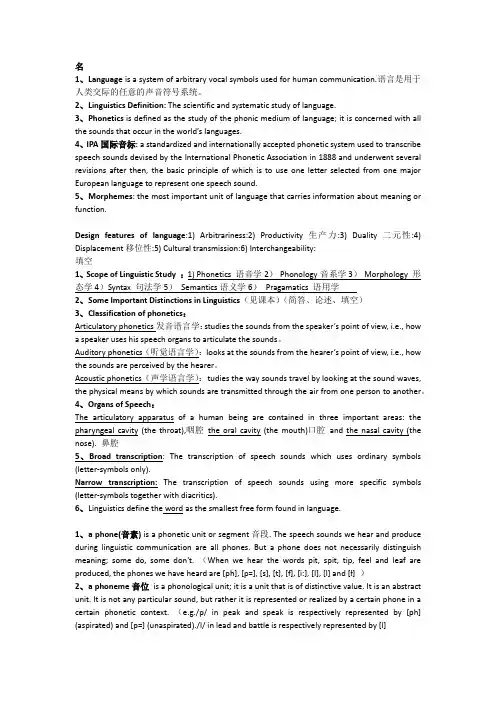
名1、Language is a system of arbitrary vocal symbols used for human communication.语言是用于人类交际的任意的声音符号系统。
2、Linguistics Definition: The scientific and systematic study of language.3、Phonetics is defined as the study of the phonic medium of language; it is concerned with all the sounds that occur in the world’s languages.4、IPA国际音标: a standardized and internationally accepted phonetic system used to transcribe speech sounds devised by the International Phonetic Association in 1888 and underwent several revisions after then, the basic principle of which is to use one letter selected from one major European language to represent one speech sound.5、Morphemes: the most important unit of language that carries information about meaning or function.Design features of language:1) Arbitrariness:2) Productivity生产力:3) Duality二元性:4) Displacement移位性:5) Cultural transmission:6) Interchangeability:填空1、Scope of Linguistic Study :1) Phonetics 语音学2)Phonology音系学3)Morphology 形态学4)Syntax 句法学5)Semantics语义学6)Pragamatics 语用学2、Some Important Distinctions in Linguistics(见课本)(简答、论述、填空)3、Classification of phonetics:Articulatory phonetics发音语言学:studies the sounds from the speaker’s point of view, i.e., how a speaker uses his speech organs to articulate the sounds。
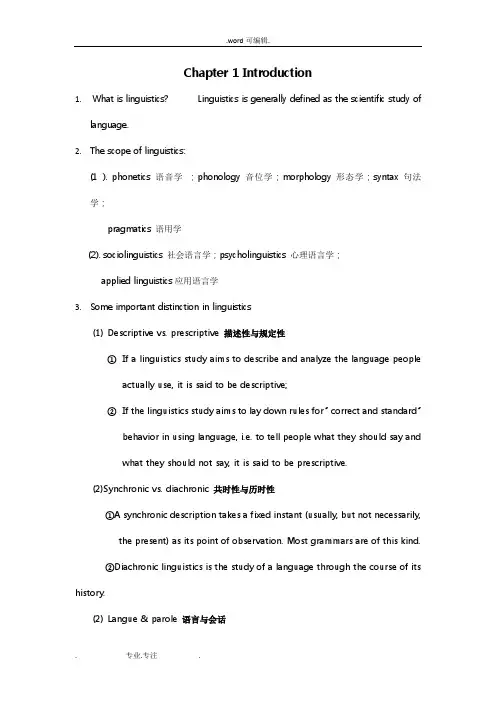
Chapter 1 Introduction1. What is linguistics? Linguistics is generally defined as the scientific study oflanguage.2.The scope of linguistics:(1 ). phonetics 语音学;phonology 音位学;morphology 形态学;syntax 句法学;pragmatics 语用学(2). sociolinguistics 社会语言学;psycholinguistics 心理语言学;applied linguistics应用语言学3.Some important distinction in linguistics(1)Descriptive vs. prescriptive 描述性与规定性①If a linguistics study aims to describe and analyze the language peopleactually use, it is said to be descriptive;②If the linguistics study aims to lay down rules for” correct and standard”behavior in using language, i.e. to tell people what they should say andwhat they should not say, it is said to be prescriptive.(2)Synchronic vs. diachronic 共时性与历时性①A synchronic description takes a fixed instant (usually, but not necessarily,the present) as its point of observation. Most grammars are of this kind.②Diachronic linguistics is the study of a language through the course of its history.(2)Langue & parole 语言与会话①Language refers to the abstract linguistic system shared by all themembers of a speech community.②Parole refers to the realization of language in actual use.(4)Competence and performance 语言能力与语言运用①A language user's unconscious knowledge about the system of rules iscalled his linguistic competence.②Performance refers to the actual use of language in concrete situations.(5)speech and writing 语言与文字Speech and writing are the two major media of communication.(6)traditional grammar and modern linguistic 传统语法与现代语言学4.Definition of language:Language is a system of arbitrary vocal symbols used for human communication.Language is a system, i.e., elements of language are combined according to rules.Language is arbitrary in the sense that there is no intrinsic connection between a linguistics symbol and what the symbol stands.Language is vocal because the primary medium for all languages is sound.The term “human” in the definition is meant to specify that language is human-specific.5.Design features of language6.(1) Arbitrariness 任意性refers to the forms of linguistic signs bear no naturalrelationship to their meaning. (sounds and meanings)(2) Productivity(creativity)能产性Language is productive in that it makes possiblethe construction and interpretation of new signals by its users.(3) duality双重性The property of having two levels of structures, such that units ofthe primary level are composed of elements of the secondary level and each of the two levels has its own principles of organization.(4) displacement移位性Human Languages enable their users to symbolize objects,events and concepts which are not present (in time and space) at moment of communication.(5)cultural transmission 文化传承性7.Functions of language(1) referential (to convey message and information),(2) poetic (to indulge in language for its own sake),(3) emotive (to express attitudes, feelings and emotions),(4) conative (to persuade and influence others through commands and requests),(5) phatic (to establish communion with others)(6) metalingual (to clear up intentions and meanings).①Informative(信息功能): to give information about facts. (ideational)②Interpersonal(人际功能): to establish and maintain social status in asociety.(age, sex, language, background, accent, status)③Performative(施为功能) : language is used to do things, to perform certainactions. (name, promise, apologize, sorry, declare)④. Emotive/Expressive (情感功能): to express feelings and attitudes of thespeaker.⑤Phatic communion(寒暄交流) : to use small and meaningless expressions toestablish a comfortable relationship or maintain social contact between people without any factual content. (health, weather)⑥Recreational function(娱乐): the use of language for sheer joy. (lyrics, poetry)⑦Metalingual function(元语言功能): to talk about language itself.8.9.Chapter 2 Phonology1.Phonetics(语音学)is the study of the phonic medium of language; it isconcerned with all the sounds that occur in the world’s languages. Phonetics studies how speech sounds are produced, transmitted, and perceived.2.Orthographic representation of speech sounds:broad transcription(宽式标音)and narrow transcription(严式标音)A broad transcription(宽式标音)is the transcription with letter-symbols only.A narrow transcription(严式标音)is a transcription with letter symbols togetherwith diacritics.3.Phonology(音位学)is the study of the sound patterns and sound systems oflanguages.4.The differences between phonetics and phonology:(语音的正字表征)①Both are concerned with the same aspect of language----the speech sounds. Butthey differ in their approach and focus.②Phonetics is of general nature; it is interested in all the speech sounds used in allhuman languages; it aims to answer questions like: how they are produced, how they differ from each other, what phonetic features they have, how they can be classified, etc.③Phonology aims to discover how speech sounds in a language form patterns and how these sounds are used to convey meaning in linguistic communication.5.Phone(音素), phoneme(音位), allophone(音位变体)A phone---- a phonetic unit or segment. The speech sounds we hear and produceduring linguistic communication are all phones.A phoneme---- is a phonological unit; it is a unit of distinctive value; an abstract unit,not a particular sound, but it is represented by a certain phone in certain phonetic context6.Phonemic contrast, complementary distribution and minimal pair.(音位对立,互补分布,最小对立体)7.Some rules of phonology(音位学规则)Sequential rules 序列规则Assimilation rule 同化规则Deletion rule省略规则8.Suprasegmental features (超音段特征):stress重音,tone音调,intonation语调9.10.Chapter 3 Morphology1.Classification of words(1)Variable vs. invariable words:可变词类和不可变词类Variable words: One could find ordered and regular series of grammatically different word forms; on the other hand, part of the word remains constant follow, follows, following, followed; mat, matsInvariable words: those words such as since, when, seldom, through, hello. They do not have inflective endings.(2)Grammatical words vs. lexical words:语法词类和词汇词类Grammatical words: express grammatical meanings, such as conjunctions, prepositions, articles, pronounsLexical words: have lexical meanings, those which refer to substance, action and quality, such as nouns, verbs, adjectives, and adverbs.(3)Closed-class words vs. open-class words:封闭词类和开放词类Closed-class: a word whose membership is fixed or limited. New members are not regularly added. Pronouns, prepositions, conjunctions, articles, etc.Open-class: A word whose membership is in principle infinite or unlimited. Nouns, verbs, adjectives, adverbsGrammatical---lexical words closed-class---open-class words2.Morphere(词素):the minimal meaningful unit of language.3.Linguistics use the term morphology to refer the part of the grammar that isconcerned with word formation and word structure.4.Free morpheme & bound morpheme(自由语素和黏着语素)A morpheme which can be a word by itself is called a free morpheme; a morphemethat must be attached to another one is a bound morpheme.5.The variant forms of a morpheme are called its allomorphs.(词素变体)6.Inflectional affix & derivational affix(屈折词缀和派生词缀)pound: those words that consist of more than one free morphemes, the way tojoin two separate words to produce a single form.In compounds, the lexical morphemes can be of different word classes.pounds can be further divided into two kinds:the endocentric compound (向心复合词) the exocentric compound(离心复合词)9.Endocentric: one element serves as the head, the relationship of “a kind of”; egself-control: a kind of control armchair: a kind of chair10.Exocentric: there is no head, so not a relationship of “a kind of something”, egscarecrow: not a kind of crow breakneck: not a kind of neck11.Chapter 4 Syntax1.What is Syntax (句法)?Syntax is the study of the rules governing the ways different constituents are combined to form sentences. 句法就是研究语言的不同成分组成句子的规则2.Syntactic relations can be analyzed into three kinds:relations of position 位置关系relations of substitutability 替代关系relations of co-occurrence 同现关系3.4.5.Chapter 5 Semantics1.What is Semantics?Semantics is the study of the meaning of words, phrases and sentences.语义学是研究单词、短语和句子的意义的学科2.The conceptualist view①The conceptualist view holds that there is no direct link between a linguistic formand what it refers to (i.e. between language and the real world); rather, in the interpretation of meaning they are linked through the mediation of concepts in the mind.②This is illustrated by the classic semantic triangle or triangle of significancesuggested by Ogden and Richard.Thought/reference/conceptSymbol/form referencentword/phrase/sentence③The symbol or form refers to the linguistic elements (words andphrases);The referent refers to the object in the world of experience;Thought or reference refers to concept.The symbol or a word signifies things by virtue of the concept associated withthe form of the word in the minds of the speaker; and the concept looked atfrom this point of view is the meaning of the word.3.The contextualismMeaning should be studied in terms of situation, use, context—elements closely linked with language behavior. Two types of contexts are recognized:Situational context: spatiotemporal situationLinguistic context: the probability of a word’s co-occurrence or collocation.4.BehaviorismBehaviorists attempted to define meaning as “the situation in which the speaker utters it and the response it calls forth in the hearer”.5.Lexical meaningSense and reference are both concerned with the study of word meaning. They are two related but different aspects of meaning.Sense---- is concerned with the inherent meaning of the linguistic form. It is the collection of all the features of the linguistic form; it is abstract and de-contextualized.It is the aspect of meaning dictionary compilers are interested in.Reference----what a linguistic form refers to in the real, physical world; it deals with the relationship between the linguistic element and the non-linguistic world of experience.6.Major sense relations(1)Synonymy 同义词①Dialect synonymy 方言同义词②Stylistic synonymy 文体同义词③Synonyms that differ in their emotive or evaluative meaning④Collocational synonyms⑤Semantically different synonyms(2)Antonym 反义词①Gradable antonyms 等级反义词②Complementary antonyms 互补反义词③Relational opposites 关系反义词(3)Polysemy 一词多义(4)Homonymy 同形异义词(5)Hyponymy 上下义关系①Superordinate 上义词②Hyponyms下义词ponential analysis 成分分析法——a way of analyze lexical meaningIt is a way proposed by the structural semanticists to analyze word meaning.The.word可编辑.approach is based on the belief that the meaning of a word can be dissected into meaning components, called semantic features.8.. 专业.专注.。
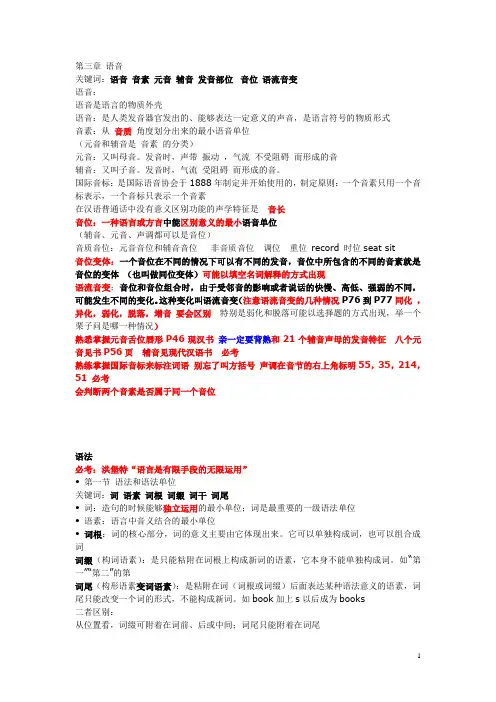
第三章语音关键词:语音音素元音辅音发音部位音位语流音变语音:语音是语言的物质外壳语音:是人类发音器官发出的、能够表达一定意义的声音,是语言符号的物质形式音素:从音质角度划分出来的最小语音单位(元音和辅音是音素的分类)元音:又叫母音。
发音时,声带振动,气流不受阻碍而形成的音辅音:又叫子音。
发音时,气流受阻碍而形成的音。
国际音标:是国际语音协会于1888年制定并开始使用的,制定原则:一个音素只用一个音标表示,一个音标只表示一个音素在汉语普通话中没有意义区别功能的声学特征是音长音位:一种语言或方言中能区别意义的最小语音单位(辅音、元音、声调都可以是音位)音质音位:元音音位和辅音音位非音质音位调位重位record 时位seat sit音位变体:一个音位在不同的情况下可以有不同的发音,音位中所包含的不同的音素就是音位的变体(也叫做同位变体)可能以填空名词解释的方式出现语流音变:音位和音位组合时,由于受邻音的影响或者说话的快慢、高低、强弱的不同,可能发生不同的变化。
这种变化叫语流音变(注意语流音变的几种情况P76到P77同化,异化,弱化,脱落,增音要会区别特别是弱化和脱落可能以选择题的方式出现,举一个栗子问是哪一种情况)熟悉掌握元音舌位唇形P46现汉书亲一定要背熟和21个辅音声母的发音特征八个元音见书P56页辅音见现代汉语书必考熟练掌握国际音标来标注词语别忘了叫方括号声调在音节的右上角标明55,35,214,51 必考会判断两个音素是否属于同一个音位语法必考:洪堡特“语言是有限手段的无限运用”• 第一节语法和语法单位关键词:词语素词根词缀词干词尾• 词:造句的时候能够独立运用的最小单位;词是最重要的一级语法单位• 语素:语言中音义结合的最小单位• 词根:词的核心部分,词的意义主要由它体现出来。
它可以单独构成词,也可以组合成词词缀(构词语素):是只能粘附在词根上构成新词的语素,它本身不能单独构成词。
如“第一”“第二”的第词尾(构形语素变词语素):是粘附在词(词根或词缀)后面表达某种语法意义的语素,词尾只能改变一个词的形式,不能构成新词。
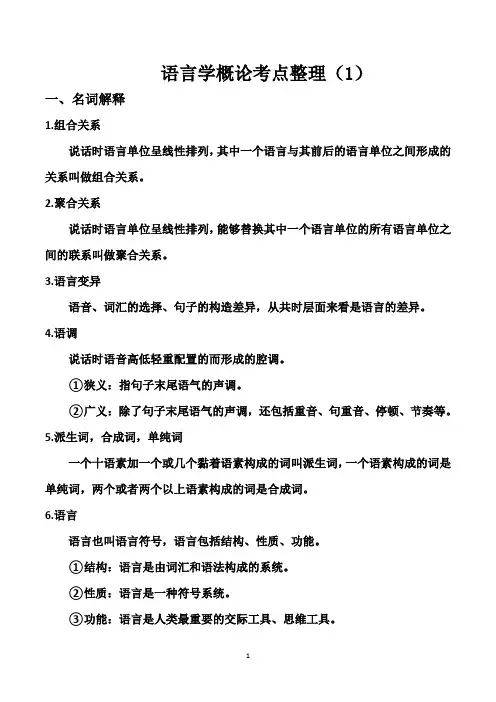
语言学概论考点整理(1)一、名词解释1.组合关系说话时语言单位呈线性排列,其中一个语言与其前后的语言单位之间形成的关系叫做组合关系。
2.聚合关系说话时语言单位呈线性排列,能够替换其中一个语言单位的所有语言单位之间的联系叫做聚合关系。
3.语言变异语音、词汇的选择、句子的构造差异,从共时层面来看是语言的差异。
4.语调说话时语音高低轻重配置的而形成的腔调。
①狭义:指句子末尾语气的声调。
②广义:除了句子末尾语气的声调,还包括重音、句重音、停顿、节奏等。
5.派生词,合成词,单纯词一个十语素加一个或几个黏着语素构成的词叫派生词,一个语素构成的词是单纯词,两个或者两个以上语素构成的词是合成词。
6.语言语言也叫语言符号,语言包括结构、性质、功能。
①结构:语言是由词汇和语法构成的系统。
②性质:语言是一种符号系统。
③功能:语言是人类最重要的交际工具、思维工具。
7.语言结构的层次性(二层性)语言结构包括上层和下层次,上层次性有三种,第一层是语素,第二层是词,第三层是句子。
下层次性是首位,它们的特点是每一层都是上下面一层组合而成。
8.语法范畴把语法意义进一步综合概括形成的意义类别,称为语法范畴。
9.重音重音分为词重音和句重音,词重音是一个词中重读的音节,句重音是一个句子中重读的词或者词组。
10.词、语素、句子①词是能够独立运用的最小的造句单位。
②语素是最小的语音和语义结合体。
③句子是语言的使用单位,句子表达一个完整的意思并体现说话人的态度。
11.义素义素是构成词义的基本要素。
12.隐性结构、显性结构隐性结构:(1)可以是非连续性的;(2)可以是间接成分之间的关系;(3)一个成分可以同其他成分发生多种关系。
显性结构:(1)成分之间是连续的;(2)是直接成分之间的关系;(3)成分之间的关系是单一的。
二、简答题1.音位和音素有什么区别?(1)定义不同音位:具有区别意义作用的最小语音单位。
音素:从音色角度划分出来的最小语音单位。

语言学名著导读整理一、填空1、《普通语言学教程》是索绪尔唯一的著作,但它是现代语言学经典性的奠基之作。
2、索绪尔是现代语言学和结构主义语言学的创始人,是当之无愧的现代语言学之父。
3、索绪尔《普通语言学》三组重要关系:语言和言语、共识语言学和历时语言学、内部语言学和外部语言学。
4、叶斯伯森将词分为五类:名词、形容词、代词、动词、小品词(副词、介词、连词、感叹词)5、叶斯柏森将语言的关系分为:组合式、连系式6、布隆菲尔德首先区分了自由形式和黏附形式。
7、布龙菲尔德认为语言形式的四种配列方式:词序、变调、变音、形式的选择。
8、生成语法的创始人是乔姆斯基,代表作《最简方案》、《生成语法》9、被看做20世纪最伟大的理论著作是《生成语法》10、乔姆斯基认为儿童对外界世界的发现和判断是通过脑内先天机制产生的。
11、对语言研究采取形式主义演绎研究方法,即伽利略研究风格。
12、当代语言学研究分为形式句法和功能语法。
13、语言类型学的基本研究方法是:跨语言比较。
14、韩礼德语言学的六个核心思想:元功能或纯理功能思想、系统的思想、层次的思想、功能的思想、语境的思想、近似的或盖然的思想。
15、句法象似性的三个原则:距离象似原则、顺序象似原则、数量象似原则。
16、索绪尔《普通语言学教程》叶斯柏森《语法哲学》布龙菲尔德《语言论》乔姆斯基《最简方案》韩礼德《功能语言学导论》克罗夫特《语言类型学和普遍语法特征》二、名词解释1、向心结构:一种结构是向心的,就是其中一个成分可以代替整个结构的功能,该成分叫中心语。
分为两类:并列的,如the boy and girls;从属的,如fresh milk。
2、离心结构:一个结构是离心的,即其中任何一个成分都不能在功能上代替整个结构,如the man fell。
3、黏附形式:不能单说的语言形式叫黏附形式。
如Johnny的-y,playing的-ing。
其他所有的形式都是自由形式。
4、语言类型学:研究各种语言的特征并进行分类的学科。
Chapter 1.1.1 What is linguistics?Linguistics is the scientific科学的、系统的study of language.Linguistics studies not any particular language, but it studies languages in general.Why is linguistics a scientific study?Systematic Investigation of linguistic data, conducted with some general linguistic theories.1.3 Important distinctions in linguistics判断1.3.1 Prescriptive vs. descriptive规范性和描述性Descriptive---- describe / analyze the language people actually use.Prescriptive----lay down rules for “corr ect and standard” behaviour in using language. Descriptive vs. Prescriptive•Don’t say X.•People don’t say X.The distinction: Describing how things arePrescribing how things ought to beModern linguistics vs. grammarModern linguistics is mostly descriptive.Grammar: to set models for language users to follow.Modern linguistics is supposed to be scientific and objective and its task is to describe the language people actually use, be it "correct" or not.Modern linguists believe that whatever occurs in the language people use should be described and analyzed in their investigation.1.3.2 Synchronic vs. diachronic同步性和历时性会定义Synchronic study---description of a language at some point of time (modern linguistics) Diachronic study---description of a language through time (historical development of language over a period of time)Synchronic approach enjoys priority over a diachronic one.Synchronic or Diachronic?1.The change of vocabulary since China’s reform and opening up.2.The study of Internet language in 21st century.3.Pejorative Sense Development in English.4.The Categories and Types of Present-day English Word-Formation.1.3.4. Langue and parole语言和言语会概念(F. de Saussure:1857--1913 )Langue---- the abstract linguistic system shared by all the members of a speech communityParole ---- the realization of langue in actual use.Langue is abstract. Parole is concrete.Langue is stable. Parole varies from person to person, and from situation to situation.What linguists should do is to abstract langue from parole.1.3.5 Competence and performance 会定义(Chomsky)Competence-----the ideal user’s knowledge of the rules of his language Performance---- the actual realization of this knowledge in linguistic communication. Similarity and difference between Saussure‟s distinction and that of ChomskySimilarity: both make the distinction between the abstract language system and the actual use of language.Difference: Chomsky’s competence-performance is from psychological point of view. Saussure’s langue-parole is from sociological point of view.1.3.6 Traditional grammar and modern linguistics 要懂!判断就是下面四个Modern linguistics differs from traditional grammar in several basic ways.Firstly, linguistics is descriptive while traditional grammar is prescriptive.Secondly, modern linguistics regards the spoken language as primary, not the written.Modern linguistics differs from traditional grammar also in that it does not force languages into a Latin-based framework.1.2.2 design features of language 必须要会!Arbitrary---- no intrinsic connection between the word and the thing it denotes, e.g.“pen” by any other name is the thing we use to write with.Arbitrariness任意性Productivity/Creativity多产性Duality双重性Displacement位移性Cultural transmission 文化传播Arbitrariness----No logical (motivated or intrinsic) connection between sounds and meanings.Onomatopoeic words (which imitate natural sounds) are somewhat motivated ( English: rumble, crackle, bang, …. Chinese: putong, shasha, dingdang…)Some compound words are not entirely arbitrary, e.g. type-writer, shoe-maker, air-conditioner, photocopy…Productivity/creativity----Peculiar to human languages,users of language can understand and produce sentences they have never heard before, e.g. we can understand sentence like “ A red-eyed elephant is dancing on the hotel bed”, though it does not describe a common happening in the world.A gibbon call system is not productive for gibbon draw all their calls from a fixedrepertoire which is rapidly exhausted, making any novelty impossible.The bee dance does have a limited productivity, as it is used to communicate about food sources in any direction. But food sources are the only kind of messages that can be sent through the bee dance; bees do not “talk”about themselves, the hives, or wind, let alone about people, animals, hopes or desiresDuality (double articulation)Lower level----sounds (meaningless)Higher level----meaning (larger units of meaning)A communication system with duality is considered more flexible than one without it, fora far greater number of messages can be sent. A small number of sounds can be groupedand regrouped into a large number of units of meaning (words), and the units of meaning can be arranged and rearranged into an infinite number of sentences. (we make dictionary of a language, but we cannot make a dictionary of sentences of that language.Cultural transmission----Language is culturally transmitted (through teaching and learning; rather than by instinct).Animal call systems are genetically transmitted. All cats, gibbons and bees have systems which are almost identical to those of all other cats, gibbons and bees.A Chinese speaker and an English speaker are not mutually intelligible. This shows thatlanguage is culturally transmitted. That is, it is pass on from one generation to the next by teaching and learning, rather than by instinct.The story of a wolf child, a pig child shows that a human being brought up in isolation simply does not acquire human language.Chapter 2 phonology2.2 Phonetics2.2.1 What is phonetics?必须要会三个分支也要会Phonetics is the study of the phonic medium of language in isolation.It is concerned with production, transcription音译and classification of speech sounds.The production and perception of speech soundsSpeakerProduction Sound Waves Hearer Perception Articulatory Phonetics Acoustic Phonetics Auditory Phonetics发音语音学声学语音学听觉语音学(语音学的三个分支)2.2.3Orthographic正字法,拼字正确的representation of speech sounds - broad and narrow transcriptions 大致意思要懂Towards the end of 19th century, when articulatory phonetics had developed to such an extent in the West that scholars began to feel the need for a standardized andinternationally accepted system of phonetic transcription. Thus the International Phonetic Alphabet (IPA) came into being.Exercise: Transcription of speech wordsTask: Write the phonetic symbol for the first sound in each word according to your pronunciation.Example: zoo /z/ psycho /s/a. Judge / /b. Thomas / /c. Phone / /d. Easy / /e. Usual / /The two sounds /t/ in “Student ”are really the same?The first “t” is unaspirated (不送气)The second “t” is aspirated (送气的)./ s t j u: d ən th /The four sounds /l/ are the same?Leaf /li:f/; feel /fi:l/; build /bild/; health /helθ/Clear [l] dark [ l ] dental [l]The aspirated /h/, the dark / / are both calledDiacritics (变音符号)Two Transcriptions 严式标音记到什么程度,宽式记音记到什么程度要懂Broad transcription: The letter-symbols only.宽式标音/ /Narrow transcription: The letter-symbols+diacritics严式标音[]2.4 Classification of English Speech sounds 音素的分类要知道Vowels [元音]Consonants [辅音] 元音和辅音放一起叫做音段音位,语调,音调和重音叫做超音段音位The difference between consonants and vowelsV owels: with no obstruction through the speech organsConsonants: with obstruction through the speech organs2.2.4.1 Classification of English consonants 要知道辅音的发音分类有哪几种English consonants can be classified in two ways:1. manner of articulation根据发音方式来分类2. place of articulation. 根据发音部位来分类2.3 PhonologyThe difference between phonetics & phonology 明白各自是干嘛的Phonetics: Study sounds in isolation; one by one,phonetic features; language universalPhonology: Study sounds patterns to convey meaning; language specific2.3.2Phone, Phoneme and allophone 理解含义判断题Phone音系: 1) a phonetic unit 是语音学的一个片段2) not necessarily distinctive of meaning 不需要区分意思3) physical as perceived 物理上能感知4) marked with [ ]Phoneme音位: 1) a phonological unit 是音系学的一个片段2) distinctive of meaning 要区分意思3) abstract, not physical 抽象,不能物理上区分4) marked with / /Allophone音位变体Allophones ---- the phones that can represent a phoneme in different phonetic environments.在不同的语音学环境中代表着一个音素StudentPhones: [t] [th]Phoneme: /t/Allophone: [t] [th]Exercise(How many phones, phonemes and allophones?)Pit Spit TipLeaf, Feel, HealthBut May Rest2.3.3 phonetic contrast, complementary distribution, and minimal pair 要知道什么叫互补分布Complementary distributionComplementary distribution----allophones of the same phoneme are in complementary distribution. They do not distinguish meaning. They occur in different phonetic contexts,e.g.dark [l] & clear [l], aspirated [p] & unaspirated [p]. [t] [th] Two allophones2.3.4 some rules in phonology 3条规则要明白是什么意思判断题2.3.4.1 sequential rules 序列规则There are rules that govern the combination of sounds in a particular language. These rules are called Sequential rules (序列规则)1.What are possible sequences if 3 consonants cluster together at the beginning of a word?2.3.4.2 assimilation rule 同化规则The assimilation rule assimilates one sound to another by “copying” a feature of a sequential phoneme, thus making the two phones similar. (同化规则)3. Give examples to show how the assimilation rule works in English.2.3.4.3 deletion rules 省略规则Deletion rule tells us when a sound is to be deleted although it is orthographically represented. Deletion /g/ occurs before a final nasal consonant. Sign design…比如l r 后面只允许出现元音这是什么规则在约束它是同化规则在约束它错@!应该是序列规则在约束它要知道序列规则该怎么写2.3.5 suprasegmental features ----stress tone声调intonation语调只需知道超音段音位包括哪些就可以了英语中tone算不算超音段音位?不算所谓是音位,需要能够区分意义5. List different types of stress patterns that can distinguish meaning. (Task)1)To distinguish some nouns from their related verbs.` import (n.) —im` port (v.)`record (n.) —re`cord (v.)2) To distinguish compounds from noun phrases.`hotdog (n.) — hot `dog (phrase)3)To distinguish the compound combinations of -ing modifiers and nouns and the phrasalcombinations of-ing forms for the action and nouns for the doer.`sleeping car (compound) —ֽsleeping `boy (phrase)4)To distinguish content words from function words in sentences.He is `driving my `car.5)To emphasize to a certain part of a sentence.I prefer `small apples, those are far too large.7. What is the difference between tone and intonation?1)Tone refers to pitch movement in spoken utterances that is related to differences in wordmeaning.2)Intonation refers to pitch movement in spoken utterances that is not related todifferences in word meaning.Chapter 3 morphology 形态学morphology 的概念要会3.1 Morphology refers to the study of the internal structure of words and the rules bywhich words are formed. 词的内部结构的学习和词形成的规则3.2 open class and closed class 开放词类和封闭词类需要注意既不是开放的也不是封闭的词Open class words----content words of a language to which we can regularly add new words, such as nouns, adjectives, verbs and adverbs, e.g. beatnik(a member of the Beat Generation), hacker, email, internet, “做秀,时装秀…” in Chinese.Closed class words----grammatical or functional words, such as conjunction, articles, preposition and pronouns.封闭词类和开放词类就语法功能来说,词可分为:封闭词类(Closed Class)和开放词类(Open Class)。
1.Linguistics: Linguistics is generally defined as the scientific study oflanguage.2.Phonology: The study of how sounds are put together and used incommunication is called phonology.3.Syntax: The study of how morphemes and words are combined to formsentences is called syntax. .4.Design features: it referred to the defining properties of human languagethat tell the difference between human language that tell the difference between human language and any system of animal communication.5.Psycholinguistics: The study of language with reference to the workings ofmind is called psycholinguistics.nguage: Language is a system of arbitrary vocal symbols used for humancommunication.7.Phonetics: The study of sounds which are used in linguistic communication iscalled phonetics.8.Morphology: The study of the way in which morphemes are arranged to formwords is called morphology.9.Parole: it referred to the actual phenomena or data of linguistics.10.P honology:Phonology studies the system of sounds of a particular language;it aims to discover how speech sounds in a language form patterns and how these sounds are used to convey meaning in linguistic communication. 11.P honeme:The basic unit in phonology is called phoneme;it is a unit ofdistinctive value. But it is an abstract unit. To be exact,a phoneme is nota sound;it is a collection of distinctive phonetic features.12.A llophone:The different phones which can represent a phoneme in differentphonetic environments are called the allophones of that phoneme.13.I nternational phonetic alphabet:It is a standardized and internationallyaccepted system of phonetic transcription.14.I ntonation:When pitch,stress and sound length are tied to the sentencerather than the word in isolation,they are collectively known as intonation.15.P honetics:Phonetics is defined as the study of the phonic medium oflanguage;it is concerned with all the sounds that occur in the world' s languages16.A uditory phonetics:It studies the speech sounds from the hearer's point ofview. It studies how the sounds are perceived by the hearer.17.A coustic phonetics:It studies the speech sounds by looking at the soundwaves. It studies the physical means by which speech sounds are transmitted through the air from one person to another.18.P hone:Phones can be simply defined as the speech sounds we use whenspeaking a language. A phone is a phonetic unit or segment. It does not necessarily distinguish meaning.19.P honemic contrast:Phonemic contrast refers to the relation between twophonemes. If two phonemes can occur in the same environment and distinguish meaning,they are in phonemic contrast.20.T one:Tones are pitch variations,which are caused by the differing ratesof vibration of the vocal cords.21.M inimal pair:When two different forms are identical in every way except forone sound segment which occurs in the same place in the strings,the two words are said to form a minimal pair.22.M orphology:Morphology is a branch of grammar which studies the internalstructure of words and the rules by which words are formed.23.I nflectional morphology:The inflectional morphology studies the inflections24.D erivational morphology:Derivational morphology is the study of word-formation.25.M orpheme:It is the smallest meaningful unit of language.26.F ree morpheme:Free morphemes are the morphemes which areindependent units of meaning and can be used freely all by themselves or in combination with other morphemes.27.B ound morpheme:Bound morphemes are the morphemes which cannot beused independently but have to be combined with other morphemes,either free or bound,to form a word.28.R oot:A root is often seen as part of a word;it can never stand by itself al-though it bears clear,definite meaning;it must be combined with another root or an affix to form a word.29.A ffix:Affixes are of two types:inflectional and derivational. Inflectionalaffixes manifest various grammatical relations or grammatical categories,while derivational affixes are added to an existing form to create a word.30.P refix:Prefixes occur at the beginning of a word. Prefixes modify themeaning of the stem,but they usually do not change the part of speech of the original word.31.S uffix:Suffixes are added to the end of the stems;they modify themeaning of the original word and in many cases change its part of speech.32.D erivation:Derivation is a process of word formation by which derivativeaffixes are added to an existing form to create a word.33.C ompounding:Compounding can be viewed as the combination of two orsometimes more than two words to create new words.34.S yntax:Syntax is a subfield of linguistics. It studies thesentence structureof language. It consists of a set of abstract rules that allow words to be combined with other words to form grammatical sentences.35.S entence: A sentence is a structurally independent unit that usuallycomprises a number of words to form a complete statement,question or command. Normally, a sentence consists of at least asubject and a predicate which contains a finite verb or a verb phrase.36.C oordinate sentence:A coordinate sentence contains two clauses joined bya linking word called coordinating conjunction,such as "and","but","or".37.S yntactic categories:Apart from sentences and clauses, a syntacticcategory usually refers to a word (called a lexical category)or a phrase (called a phrasal category)that performs a particular grammatical function.38.G rammatical relations:The structural and logical functional relations ofconstituents are called grammatical relations. The grammatical relations of a sentence concern the way each noun phrase in the sentence relates to the verb. In many cases,grammatical relations in fact refer to who does what to whom.39.L inguistic competence:Universally found in the grammars of all humanlanguages,syntactic rules comprise the system of internalized linguistic knowledge of a language speaker known as linguistic competence.40.T ransformational rules:Transformational rules are the rules that transformone sentence type into another type.41.D-structure:D-structure is the level of syntactic representation that existsbefore movement takes place. Phrase structure rules,with the insertion of the lexicon,generate sentences at the level of D-structure.42.S emantics:Semantics can be simply defined as the study of meaning inlanguage.43.S ense:Sense is concerned with the inherent meaning of the linguistic form.It is the collection of all the features of the linguistic form;it is abstract and de -contextualized.44.R eference:Reference means what a linguistic form refers to in the real,physical world;it deals with the relationship between the linguistic element and the non-linguistic world of experience45.S ynonymy:Synonymy refers to the sameness or close similarity ofmeaning.46.P olysemy:Polysemy refers to the fact that the same one word may havemore than one meaning.47.H omonymy:Homonymy refers to the phenomenon that words havingdifferent meanings have the same form,i.e. different words are identical in sound or spelling,or in both.48.H omophones:When two words are identical in sound,they are calledhomophones.49.H omographs:When two words are identical in spelling,they arehomographs.50.C omplete homonyms:When two words are identical in both sound andspelling,they are called complete homonyms.51.H yponymy:Hyponymy refers to the sense relation between a moregeneral,more inclusive word and a more specific word.52.A ntonymy:Antonymy refers to the relation of oppositeness of meaning.53.C omponential analysis:Componential analysis is a way to analyze wordmeaning. It was proposed by structural semanticists. The approach is based on the belief that the meaning of a word can be divided into meaning components,which are called semantic features.54.T he grammatical meaning:The grammatical meaning of a sentence refersto its grammaticality,i.e. its grammatical well-formedness. The grammaticality of a sentence is governed by the grammatical rules of the language.55.P redication:The predication is the abstraction of the meaning of a sentence.56.A rgument:An argument is a logical participant in a predication. It isgenerally identical with the nominal element (s)in a sentence.57.P redicate:A predicate is something that is said about an argument or itstates the logical relation linking the arguments in a sentence.58.T wo-place predication:A two-place predication is one which contains twoarguments.59.P ragmatics:Pragmatics can be defined as the study of how speakers of alanguage use sentences to effect successful communication.60.C ontext:Generally speaking,it consists of the knowledge that is shared bythe speaker and the hearer. The shared knowledge is of two types:theknowledge of the language they use,and the knowledge about the world,including the general knowledge about the world and the specific knowledge about the situation in which linguistic communication is taking place.61.U tterance meaning:The meaning of an utterance is concrete,andcontext-dependent. Utterance is based on sentence meaning;it is realization of the abstract meaning of a sentence in a real situation of communication,or simply in a context.62.S entence meaning:The meaning of a sentence is often considered as theabstract,intrinsic property of the sentence itself in terms of a predication.63.C onstative:Constatives were statements that either state or describe,andwere verifiable.64.P erformative:performatives,on the other hand,were sentences that didnot state a fact or describe a state,and were not verifiable. Their function is to perform a particular speech act.65.L ocutionary act:A locutionary act is the act of uttering words,phrases,clauses. It is the act of conveying literal meaning by means of syntax,lexicon and phonology.66.I llocutionary act:An illocutionary act is the act of expressing the speaker'sintention;it is the act performed in saying something.67.P erlocutionary act:A perlocutionary act is the act performed by or resultingfrom saying something;it is the consequence of,or the change brought about by the utterance;it is the act performed by saying something. 68.C ooperative Principle:It is principle advanced by Paul Grice. It is a principlethat guides our conversational behaviours. The content is:Make your conversational contribution such as is required at the stage at which it occurs by the accepted purpose or the talk exchange in which you are engaged.69.S ociolinguistics:Sociolinguistics is the study of language in social contexts.70.S peech community:The social group isolated for any given study is calledthe speech community or a speech community is a group of people who forma community and share the same language or a particular variety oflanguage. The important characteristic of a speech community is that the members of the group must,in some reasonable way,interact linguistically with other members of the community. They may share closely related language varieties,as well as attitudes toward linguistic norms.71.S peech variety:Speech variety,also known as language variety,refersto any distinguishable form of speech used by a speaker or group of speakers. The distinctive characteristics of a speech variety may be lexical,phonological,morphological,syntactic,or a combination of linguistic features.72.L anguage planning:Language standardization is known as languageplanning. This means that certain authorities,such as the government or government agency of a country,choose a particular speech variety and spread the use of it,including its pronunciation and spelling systems,across regional boundaries.73.I diolect:An idiolect is a personal dialect of an individual speaker that com-bines aspects of all the elements regarding regional,social,and stylistic variation,in one form or another. In a narrower sense,what makes up one’s idiolect includes also such factors as voice quality,pitch and speech rhythm,which all contribute to the identifying features in an individual's speech.74.S tandard language:The standard language is a superposed,sociallyprestigious dialect of language. It is the language employed by the government and the judiciary system,used by the mass media,and taught in educational institutions,including school settings where the language is taught as a foreign or second language.75.N onstandard language:Language varieties other than the standard arecalled nonstandard languages.76.L ingua franca:A lingua franca is a variety of language that serves as amedium of communication among groups of people for diverse linguistic backgrounds.77.P idgin:A pidgin is a variety of language that is generally used by nativespeakers of other languages as a medium of communication.78.C reole:A Creole language is originally a pidgin that has become establishedas a native language in some speech community.79.D iglossia:Diglossia usually describes a situation in which two very differentvarieties of language co-exist in a speech community,each with a distinct range of purely social function and appropriate for certain situations.80.B ilingualism:Bilingualism refers to a linguistic situation in which twostandard languages are used either by an individual or by a group of speakers,such as the inhabitants of a particular region or a nation.81.E thnic dialect:Within a society,speech variation may come about becauseof different ethnic backgrounds. An ethnic language variety is a social dialect of a language,often cutting across regional differences. An ethnic dialect is spoken mainly by a less privileged population that has experienced some form of social isolation,such as racial discrimination or segregation. 82.S ociolect:Social dialects,or sociolects,are varieties of language used bypeople belonging to particular social classes.83.R egister:Registers are language varieties which are appropriate for use inparticular speech situations,in contrast to language varieties that are associated with the social or regional grouping of their customary users.Format reason,registers are also known as situational dialects.84.S lang:Slang is a casual use of language that consists of expressive butnon-standard vocabulary,typically of arbitrary,flashy and often ephemeral coinages and figures of speech characterized by spontaneity and sometimes by raciness.85.T aboo:Taboo,or rather linguistic taboo,denotes any prohibition by thepolite society on the use of particular lexical items to refer to objects or acts.86.E uphemism:A euphemism,then,is a mild,indirect or less offensive wordor expression substituted when the speaker or writer fears more direct wording might be harsh,unpleasantly direct,or offensive.。
自考英语语言学复习大纲Chapter 1Introduction 绪论1.What is linguistics?什么是语言学1.1Definition:Linguistics is generally defined as scientific study of language.语言学普遍被定义为对语言进行的科学研究。
2.What is language?什么是语言?2.1Definitions:Language is a system of arbitrary vocal symbols used for human communication.语言是用于人类交流的一个任意的语音符号系统。
(1)language is a system (2)language is arbitrary (3)language is vocal (4)language is human specific Chapter 2Phonology 音位学1.The phonic medium of language 语言的语音媒介2.Phonetics 语音学 a.The study of language as a whole is often called general linguistics.普通语言学。
b.The study of sounds,which are used in linguistic communication is called phonetics.语音学c.The study of how sounds are put together and used in communication is called phonology.音位学d.The study of the way in which morphemes are arranged to form words are called morphology.形态学e.The study of how morphemes and words are combined to form sentences is called syntax.句法学f.The study of meaning in language is called semantics.语义学g.The study of meaning in context of use is called pragmatics.语用学h.The study of language with reference to society is called sociolinguistics.社会语言学i.The study of language with reference to the working of mind is called psycholinguistics.心理语言学j.The study of applications(as the recovery of speech ability)is general known as applied linguistics.应用语言学h.Other related branches include anthropological linguistics,(人类语言学)neurological linguistics(神经语言学),mathematical linguistics(数字语言学)and computational linguistics(计算机语言学).1.2The scope of linguistics 语言学的研究范畴a.语言的任意性(武断性)Arbitrarinessb.语言的能产性Productivityc.语言的双重性Dualityd.语言的移位性Displacemente.语言的文化传递性Cultural transmission1Prescriptive vs.Descriptive 规定性与描写性2Synchronic vs.Diachronic 共时性与历时性(Saussure)3Speech and Writing 口头语和书面语4Langue and Parole (both from French words)语言(抽象)和言语(具体)(Saussure)5Competence and Performance 语言能力与语言运用(Chomsky)1.3Some important distinctions in linguistics 语言学研究中的一些重要的区分2.2Design features语言的甄别性特征Hockett人类语言和其他动物的交际系统区别开来的一些特征语言学内部的主要分支跨学科分支2.1Definition:phonetics is defined as the study of the phonic medium of language.语音学关注的是语言世界中的所有声音↘three points of view 2.2Organs of speech 从三个角度审视语言的发音器官2.3Orthographic representation of speech sounds —broad and narrow transcriptions IPA-International Phonetic Alphabet 国际音标语音的正字表征—宽式标音和严式标音There are two ways to transcribe speech sounds:两种标音方法2.4Classification of English speech sounds 英语语音的分类(1)articulatory phonetics 发音语音学→研究语言的产生(2)auditory phonetics 听觉语音学→研究语言怎样被感知(3)acoustic phonetics 声学语音学→研究语音的物理属性The pharyngeal cavity 咽腔(the throat)→喉咙The oral cavity 口腔(the mouth)→嘴巴The nasal cavity 鼻腔(the nose)→鼻子One is the transcription with letter-symbols only called broad transcription.The other is the transcription with letter-symbols together with the diacritics called narrow transcription.stops 闭塞音/p/,/b/,/t/,/d/,/k/,/g/fricatives 摩擦音/f/,/v/,/s/,/z/,/ʃ/,/ʒ/,/θ/,/ð/,/h/affricates 塞擦音/tʃ/,/dʒ/liquids 流音/l/,/r/nasals 鼻音/m/,/n/,/ŋ/glides 滑音/w/,/j/bilabial 双唇音/p/,/b/,/m/,/w/labiodental 唇齿音/f/,/v/dental 齿音/θ/,/ð/alveolar 齿龈音/t/,/s/,/d/,/z/,/n/,/l/,/r/palatal 鄂音/ʃ/,/ʒ/,/tʃ/,/dʒ/,/j/velar 软腭音/k/,/g/,/ŋ/glottal 喉音/h/Front 前元音/i:/,/i/,/e/,/æ/,/a/Central 中元音/ɜ:/,/ə/,/ʌ/back 后元音/u:/,/u/,/ɔ:/,/ɔ/,/a:/close vowels 闭元音/i:/,/i/,/ɜ:/,/u/semi-close vowels 半闭元音/e/,/ɜ:/semi-open vowels 半开元音/ə/,/ɔ:/open vowels 开元音/æ/,/a/,/ʌ/,/ɔ/,/a:/Consonants 辅音in terms of manner of articulation 按照发音方式in terms of place of articulation按照发音部位Vowels元音the position of the tongue in the mouth按照舌在口腔的位置the openness of the mouth 按照嘴的张合度the shape of the lips 按照嘴唇形状the length of the vowels 按照音的长度rounded vowels 圆唇元音/u:/,/u/,/ɔ:/,/ɔ/unrounded vowels 不圆唇元音/i:/,/i/,/e/,/æ/,/a/,/ɜ:/,/ə/,/ʌ/long vowels 长元音/a:/,/ɔ:/,/ə:/,/i:/,/u:/short vowels 短元音/ʌ/,/ɔ/,/ə/,/i/,/u/,/e/,/æ/monophthong 单元音在元音中还有一些双元音(diphthong),包括:/ei/,/ai/,/au/,/əu/,/ɔi/,/iə/,/εə/,/uə/3.Phonology 音位学3.1phonology and phonetics 音位学和语音学3.2phone,phoneme,allophone 音素、音位和音位变体3.3Phonemic contrast,complementary distribution,and minimal pair 音位对立,互补分布和最小对立体3.4Some rules in phonology 3.5Suprasegmental features Chapter 3Morphology 形态学1.Definition:Morphology is a branch of grammar which studies the internal structure of words and the rules by which words are formed.形态学是语法学的一个分支,它研究的是单词的内在结构及单词的构成规律。
语言学纲要知识点整理1-20一.语言学研究对象是语言语言是语言学的研究对象。
这只是一种宽泛的说法。
对语言是什么这个问题的回答就是语言学研究的内容。
人们直接面对的一般不是确切的语言,而是无处不在的语言现象。
语言学透过语言现象探索语言的本质,这个研究对象的确定过程本身就是一个语言学的发展过程。
而语言学作为一门学科的性质和特点也是在发展中形成的。
语言学的对象和学科性质是在语言学的历史发展中逐步确定的,应该从历史的角度和发展的眼光来认识这个问题。
二.语言和思维的关系1.语言:语言是人类最重要的交际工具,是词汇和语法规则的总和,是社会现象,是社会的交际工具,同时也是心理现象,是人类思维的工具。
2.思维:思维是反映客观事物一般特征、规律及相互间联系、区别的认识过程,是人类大脑特有的一种机能。
思维功能是语言功能的另一重要方面。
思维的时候需要用语言,语言和思维不可分离。
3.思维在传统上是哲学和逻辑学的概念。
逻辑学关注的思维的形式、过程、生理机制都和语言密切相关。
逻辑学把概念、判断、推理看作是思维的基本形式,这些思维的基本形式都依靠语言。
哲学中把思维看作是人类对客观事物间接的,概括的放映。
语言是思维活动的动因和载体,是思维的出储存所。
从心理学的角度看,思维是知识的认知,获取和运用的过程,是一个信息加工的过程。
客观的现实通过认知转化为主观化的信息必须要有一套符号,人类使用的最重要的符号是语言。
语言符号帮助人打成对外界的认知,储存认知的成果,并且发展人的认知能力。
认知神经科学的研究成果证明,思维作为人脑的活动,具有大脑神经生理的基础。
大脑中有专门控制语言功能的区域,和人的抽象思维能力密切相关。
由此可见,语言和思维密不可分,语言的思维功能是语言的基本属性。
4.思维离不开语言:(1)思维以语言为工具。
(2)思维的成果需要语言来巩固。
(3)语言可以帮助思维逐步深化。
(4)语言可以帮助思维条理化。
(5)语言可以帮助将思维成果传递给别人。
导言1。
语言学,顾名思义,是研究语言的科学。
语言是语言学的研究对象。
2.中国、印度和希腊-罗马是语言学的三大发源地。
3。
语言和言语的区别→语言是静态的,言语是动态的;→语言具有社会因素,言语具有个人因素;4.历史比较语言学标志着语言学不再是其他学科的附庸,已经成为一门独立的学科。
5.20世纪初,瑞士语言学家索绪尔《普通语言学教程》.誉为“现代语言学之父".结构主义语言学。
6.语言学关心的核心是编码和解码的过程。
第一章1.语言是第一性的,文字是第二性的,文字是对语言的再编码系统.文字是建立在语言基础之上的再编码形式,旗语之类则是建立在语言学或文字的基础之上的再编码形式.2.如何理解语言的社会功能?一、语言的信息传递功能(一)语言是一种特殊的社会现象1、语言是一种社会现象社会:指生活在一个共同的地域中、说同一种语言、有共同的风俗习惯和文化传统的人类共同体。
2、语言是一种特殊的社会现象语言是人类社会产生、存在和发展的必要条件,是使人与人之间取得联系的手段,是维系社会联系的纽带.(二)在人类社会中语言信息传递的作用与动物相比,人类语言的信息传递功能极其卓越。
①积累知识②分享经验感知③传递文明,促进社会进步④使人类具有生存能力和创造性。
人与人之间的信息传递是维系人类社会存在的基本前提。
(三)人类社会信息传递的其他方式及与语言的联系人们自身的面部表情、手势、躯体姿势等;佤族人用摇头表示同意…汉族人的拱手礼…借用其他物质载体;文字旗语、信号灯、警铃、电报;二、语言的人际互动功能语言的社会功能的另一个重要方面是建立或保持某种社会关联,这可称为语言的人际互动功能。
甲:出去啊?乙:出去。
人际互动功能表达了说话者的一种主观态度,是一种特殊的信息传递,它指向交际本身.简单地说,就是人在很多情况下是为了交际而交际。
人际互动包括两个方面:-说话者在话语中表达自己的情感、态度、意图;-对受话者施加了影响,得到相应的语言或行动上的反馈,从而达到某种实际效果.交际双方在主观情态表达上是彼此互动的.3.思维是认识现实世界时的动脑筋的过程,也指动脑筋时进行比较、分析、综合以认识现实的能力。
基于胡壮麟的语言学教程的网上搜集汇编资料 不针对此次考试 期末考试建议对照课本 罗列知识点 使用例子加知识点的方法复习 ---
《语言学教程》重难点学习提示 第一章 语言的性质 语言的定义:语言的基本特征(任意性、二重性、多产性、移位、文化传递和互换性);语言的功能(寒暄、指令、提供信息、询问、表达主观感情、唤起对方的感情和言语行为);语言的起源(神授说,人造说,进化说)等。 第二章 语言学 语言学定义;研究语言的四大原则(穷尽、一致、简洁、客观);语言学的基本概念(口语与书面语、共时与历时、语言与言学、语言能力与言行运用、语言潜势与语言行为);普通语言学的分支(语音、音位、语法、句法、语义);;语言学的应用(语言学与语言教学、语言与社会、语言与文字、语言与心理学、人类语言学、神经语言学、数理语言学、计算语言学)等。 第三章 语音学 发音器官的英文名称;英语辅音的发音部位和发音方法;语音学的定义;发音语音学;听觉语音学;声学语音学;元音及辅音的分类;严式与宽式标音等。 第四章 音位学 音位理论;最小对立体;自由变异;互补分布;语音的相似性;区别性特征;超语段音位学;音节;重音(词重音、句子重音、音高和语调)等。 第五章 词法学 词法的定义;曲折词与派生词;构词法(合成与派生);词素的定义;词素变体;自由词素;粘着词素(词根,词缀和词干)等。 第六章 词汇学 词的定义;语法词与词汇词;变词与不变词;封闭词与开放词;词的辨认;习语与搭配。 第七章 句法 句法的定义;句法关系;结构;成分;直接成分分析法;并列结构与从属结构;句子成分;范畴(性,数,格);一致;短语,从句,句子扩展等。 第八章 语义学 语义的定义;语义的有关理论;意义种类(传统、功能、语用);里奇的语义分类;词汇意义关系(同义、反义、下义);句子语义关系。 Chapter 1 Invitations to Linguistics 1.1. What is language? “Language is system of arbitrary vocal symbols used for human communication. It is a system, since linguistic elements are arranged systematically, rather than randomly. Arbitrary, in the sense that there is usually no intrinsic connection between a work (like “book”) and the object it refers to. This explains and is explained by the fact that different languages have different “books”: “book” in English, “livre” in French, in Japanese, in Chinese, “check” in Korean. It is symbolic, because words are associated with objects, actions, ideas etc. by nothing but convention. Namely, people use the sounds or vocal forms to symbolize what they wish to refer to. It is vocal, because sound or speech is the primary medium for all human languages, developed or “new”. Writing systems came much later than the spoken forms. The fact that small children learn and can only learn to speak (and listen) before they write (and read) also indicates that language is primarily vocal, rather than written. The term “human” in the definition is meant to specify that language is human specific.
1.3 Design features of language The features that define our human languages can be called design features which can distinguish human language from any animal system of communication. 1.3.1 Arbitrariness Arbitrariness refers to the fact that the forms of linguistic signs bear no natural relationship to their meanings. 1.3.2 Duality Duality refers to the property of having two levels of structures, such that units of the primary level are composed of elements of the secondary level and each of the two levels has its own principles of organization. 1.3.3 Creativity Creativity means that language is resourceful because of its duality and its recursiveness. Recursiveness refers to the rule which can be applied repeatedly without any definite limit. The recursive nature of language provides a theoretical basis for the possibility of creating endless sentences. 1.3.4 Displacement Displacement means that human languages enable their users to symbolize objects, events and concepts which are not present (in time and space) at the moment of conversation. 加1 Discreteness(可分离性)Each sound in the language is treated as discrete. 加2 Iconicity拟象性: the direct/non-arbitrary/non-symbolic relation between meaning and form. There are resemblances between the language form and what they refer to. That relationship is called icon. Iconicity exists in sounds, lexicons and syntax. It is the motivation between language forms and meanings. It is a relation of resemblance between language form and what they refer to.
What is cultural transmission? This means that language is not biologically transmitted from generation to generation, but that the details of the linguistic system must be learned anew by each speaker. It is true that the capacity for language in human beings(N. Chomsky called it “language acquisition device”, or LAD) has a genetic basis, but the particular language a person learns to speak is a cultural one other than a genetic one like the dog‟s barking system. If a human being is brought up in isolation he cannot acquire language. The Wolf Child reared by the pack of wolves turned out to speak the wolf‟s roaring “tongue” when he was saved. He learned thereafter, with no small difficulty, the ABC of a certain human language. What is interchangeability? Interchangeability means that any human being can be both a producer and a receiver of messages. We can say, and on other occasions can receive and understand, for example, “Please do something to make me happy.” Though some people (including me) suggest that there is sex differentiation in the actual language use, in other words, men and women may say different things, yet in principle there is no sound, or word or sentence that a man can utter and a woman cannot, or vice versa. On the other hand, a person can be the speaker while the other person is the listener and as the turn moves on to the listener, he can be the speaker and the first speaker is to listen. It is turn-taking that makes social communication possible and acceptable. Some male birds, however, utter some calls which females do not (or cannot?) , and certain kinds of fish have similar haps mentionable. When a dog barks, all the neighbouring dogs bark. Then people around can hardly tell which dog (dogs) is (are0 “speaking” and which listening. Why do linguists say language is human specific? First of all, human language has six “design features” which animal communication systems do not have, at least not in the true sense of them(see I .2-8). Let‟s borrow C. F. Hocket‟s Chart that compares human language with some animals‟ systems, from Wang Gang(1998,p.8). Secondly, linguists have done a lot trying to teach animals such as